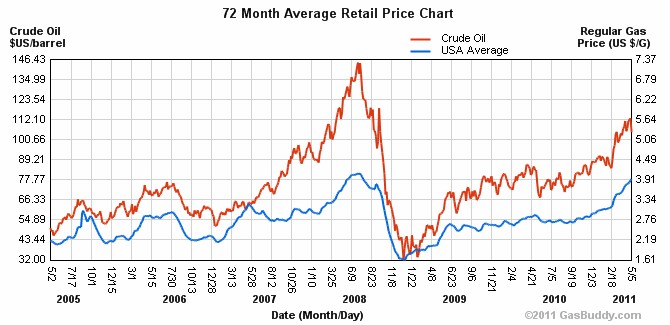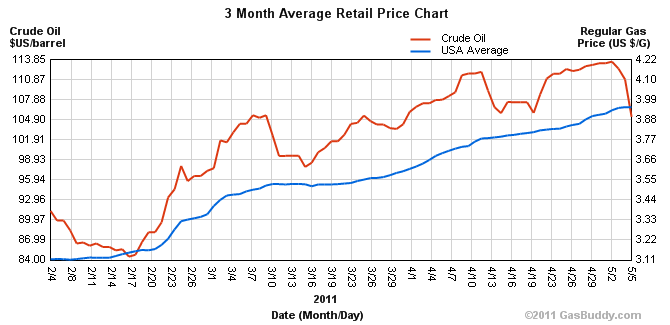One topic I remember causing a lot of confusion in my Economics courses was the behavior of the underlying price for non-renewable goods, like oil and gasoline. Now that we’re feeling the effects of rising oil prices in the form of higher gas prices at the pump, the latest conversation is around when it will end and how to bring the prices down. I’m struggling to figure out an answer, and the general irrational behavior of consumers seems to be the culprit, rather than straight economic theory. Here’s why:
Fact #1: Understand that there is a correlation in prices. The red line signifies the price of crude oil, and the blue line is the US average price of regular unleaded gas. Over the past 6 years, there has been a fairly convincing trend between the price of oil and the price of products derived from oil. This makes logical sense.
Fact #2: Ignore fact #1. Seriously. Averages are convenient statistical ways to smooth data over time. If you look at a close up shot, say 3 months instead of 6 years, you’ll see that the latest trend for oil is flat, yet the price of gas continues to rise. Why?
Economist Sam Peltzman examined this phenomenon in a paper he published in 2000 entitled “Prices Rise Faster Than They Fall“. In conclusion, there is very little theory for why gas prices stay high when oil prices fall, except to simply say “they do.” As a matter of fact, Prof. Peltzman wrote it is “a serious gap in a fundamental area of economic theory,” which clearly explains why we were all confused in class.
Fact #3: It’s the fault of the consumers. And apparently we consumers don’t care! I found this reference on MSNBC to the most plausible theory:
Matt Lewis, an economist at Ohio State University, has been studying gas prices for more than a decade. He’s considered some of the usual allegations, like pricing fixing and collusion among stations. He doesn’t entirely discount those, but he thinks he’s found a better explanation for the fast rise/slow fall phenomenon. Here’s his theory in a nutshell: When prices fall, consumers are so relieved that they stop shopping around for the best price. That eliminates the normal downward pressure on gas prices and allows stations to squeeze out a few more cents of profit while prices slowly fall.
So, why do gas prices stay high after the price of oil falls? Because consumers get lazy and gas stations get opportunistic with pricing.




